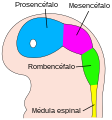Rhombencephalon
The rhombencephalon is a portion of the brain that surrounds the fourth cerebral ventricle; It is made up of myelencephalon and metencephalon together. It is located in the immediately superior part of the spinal cord and is made up of three structures: the medulla, the annular pons or pons, and the cerebellum. In it is also the fourth ventricle.
Embryology
Morphogenetically, the specialization of the rhombencephalon during embryonic life gives rise to the formation of various structures of the central nervous system in vertebrates. It is also called the primitive posterior brain, being one of the three outlines of primitive brains, together with the prosencephalon or primitive anterior brain and the midbrain or primitive middle brain.
These arise in the trilaminar embryo when, in the outermost lamina, known as the ectoderm, a group of highly specialized cells begin to form in its central part (around the third week of gestation in a human embryo). This area is known as the neuroectoderm. Around the fourth week of gestation, the neural tube is formed, which gives rise to the hindbrain along with the other two primitive brains. Subsequently, the rhombencephalon divides into eight segments called rhombomeres. The first three will give rise to the metencephalon and the next five to the myelencephalon. The metencephalon is composed of the pons and the cerebellum, while the myelencephalon forms the medulla oblongata.
Anatomy
The rhombencephalon comprises the cerebellum, pons, and medulla oblongata, which work together to support vital organic processes.
The medulla oblongata is attached to the spinal cord and controls unconscious but critical organic functions, such as breathing, swallowing, blood circulation and muscle tone.
The pons is above the bulb; its function is to establish a bridge between the brainstem and the cerebellum. The pons receives input from the vision areas to control eye and body movement; it also fulfills the functions of controlling sleep and wakefulness patterns. Information is transmitted from the pons to the cerebellum to control the coordination of muscle movement and maintain balance.
Image gallery


